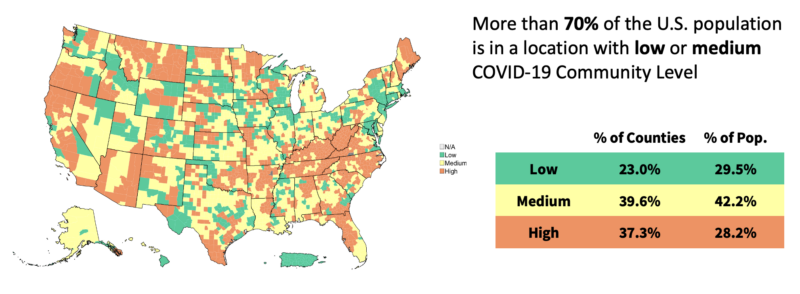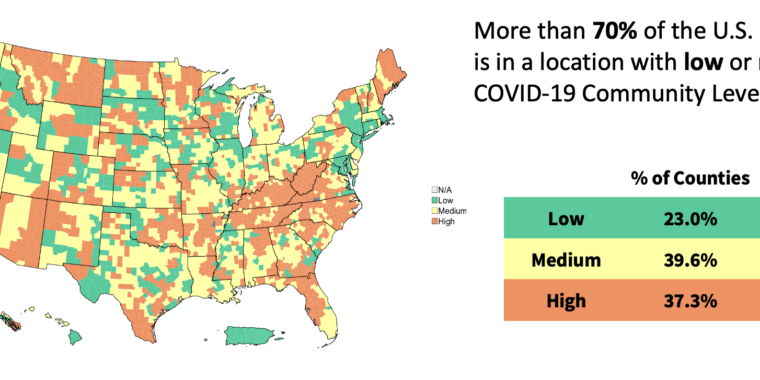
CDC
In a widely expected move, the Centers for Disease Control and Prevention announced new guidelines for the use of masks and other precautions to limit the spread of COVID-19. While the precautions people should take—vaccinations and mask use—are largely unchanged, the metrics that will trigger changes in suggested precautions will shift from being focused purely on case counts to including information on the severity of cases and hospital capacity.
The move had been hinted at for weeks, and it comes in response to a wide range of pressures. These include the rapidly falling numbers of new cases following the peak of omicron infections earlier this year, changes made in policies at the state level, and a general fatigue regarding pandemic precautions among the public. During a press call announcing the changes, however, CDC head Rochelle Walensky said the agency had been considering the changes for some time.
What’s new
Walensky announced the changes by saying, “We’re in a stronger place today,” before elaborating that this is because, “with widespread population immunity, the overall risk of severe disease is lower.” Given that situation, the CDC has decided to shift the focus of its advice to cases of severe illness and the strain those put on the health care system.
To measure that strain, the system will use three pieces of information: new hospitalizations due to COVID-19, the number of hospital beds occupied by COVID patients, and the number of new cases. These will be combined into a single metric to distinguish between low-, medium-, and high-risk scenarios. The CDC will obtain this data through a hospital reporting system and PCR-based testing labs, both of which produce information that is considered reliable.
The change makes a considerable difference. Based on the previous standard of case counts, most of the US was typically in the high-risk category. Under the new system, only about 30 percent of the US is currently considered to be at high risk. People interested in what their area’s status is can check the CDC’s page for county-level information or mask use and care, both of which were updated this afternoon.
Under low-risk conditions, people are advised to stay up to date on their vaccinations and test whenever experiencing potential COVID-19 symptoms. As risk rises to medium, people who are considered to be at high risk of severe symptoms should consult with medical professionals regarding appropriate precautions. Once risk reaches high levels, everyone should wear masks when they will be indoors in a public space.
The CDC emphasized that people are still welcome to evaluate their personal comfort and risk levels and can wear a mask in low-risk situations if they want. And there are some situations, like when people are experiencing symptoms, where masks should always be used.
What may actually change?
It’s probably safe to say that the CDC’s previous guidance was not widely followed. While the new recommendations could be used to guide state authorities, the CDC does not have the ability to compel any states to follow its suggestions; in fact, a number of states have actively sought to limit the use of mask mandates for their citizens. In others, mandates have been left in place as cases have surged and declined, even though the CDC recommends different levels of caution based on case counts.
While individuals could track local case counts and positivity levels and use those metrics to follow the CDC’s recommendations, that’s likely to be pretty rare—even though the CDC tries to make it easier through a widget that takes your location and returns the local infection levels. So it’s unclear whether this new guidance will have a large practical effect.
Walensky didn’t shy away from talking about what might be the biggest hurdle: a seemingly inevitable rise in cases that will put more of the country in the high-risk category. “We recognize that we need to be flexible,” she said. “We need to be able to dial [restrictions] back up again should we have a new variant or new surge.”
Once people get used to treating their day-to-day lives as low risk, however, “dialing back up” may pose a significant challenge.







